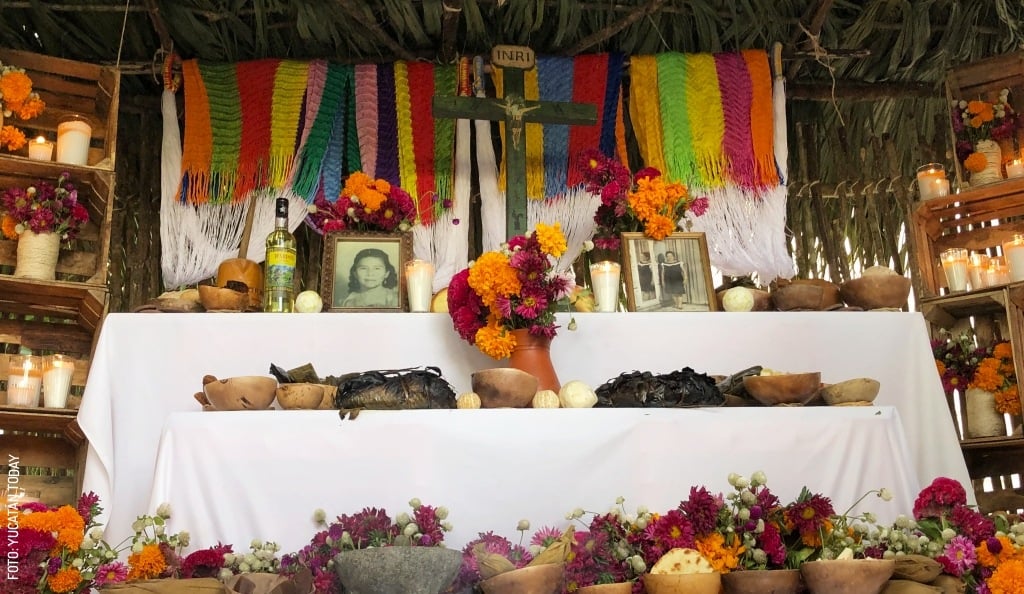Culture Spotlight: Hanal Pixán vs. Día de Muertos — How They’re Celebrated in Mérida

Every autumn in Mexico, the veil between life and death is said to grow thin — and nowhere is this more beautifully expressed than in the Yucatán peninsula, particularly in the city of Mérida. While many know about Día de Muertos (Day of the Dead), here in Yucatán the traditions take on a distinct local flavour under the name Hanal Pixán, a Mayan-influenced observance that’s just as profound, but subtly different. This blog post will help you understand the shared roots and the unique local practices of Hanal Pixán and Día de Muertos, with a focus on how Mérida honours the departed with food, altars, processions and community rituals.
Origins & Meaning: Hanal Pixán vs. Día de Muertos
Día de Muertos: A national Mexican tradition observed mainly on November 1 and 2. It developed from a syncretism of indigenous Mesoamerican ancestor-veneration practices and Spanish Catholic feasts (All Saints’ Day and All Souls’ Day). Families remember children (Nov 1) and adults (Nov 2), build altars (ofrendas) and visit cemeteries.
Hanal Pixán (sometimes spelled Janal Pixán): A Yucatecan form of Day of the Dead. The term means “food for the souls” in Mayan. It blends Mayan beliefs about souls (pixan) returning home with Catholic feast-days and local food traditions.
So what’s the difference? Hanal Pixán emphasises food, offerings and family remembrance in a Mayan cultural framework, while Día de Muertos (in broader Mexico) emphasises altars, skull imagery, parades, and often a more festive public spectacle. In Mérida both traditions overlap — you’ll often hear Hanal Pixán talked about instead of the generic Día de Muertos.
What It Looks Like in Mérida
In Mérida the celebration stretches over several days (often late October through early November) and is filled with a rich mix of ritual, food, family time, and public events.
Key local elements in Mérida:
-
Altars in homes, neighbourhoods and public plazas: In the city centre at the Plaza Grande you’ll find one of the largest altars.
-
A food focus: The signature dish is mucbipollo (also “pib”) — a large underground-cooked tamale made for the souls.
-
Processions and public performances: The “Paseo de las Ánimas” (Walk of the Souls) is a procession where costumed participants move through town, often culminating at a cemeterial or cultural site.
-
Cemetery visits and family gatherings: Families clean and decorate graves, leave offerings, and share food. In Yucatán the tone is more introspective and family-oriented than major carnivals in some other regions.
The Rituals & Symbolism
Altars (ofrendas):
-
In Yucatán the altar is often built with layered levels representing the living world, the intermediate, and the spiritual world.
-
Offerings include the beloved foods of the deceased, candles, marigold flowers (cempasúchil), photos, personal items, salt and water.
-
In Mérida some public altars span enormous dimensions — in 2023 the altar at Plaza Grande measured approximately 52 feet long by 13 feet tall.
Food as ritual:
-
Mucbipollo: The large tamale cooked underground is emblematic of the Yucatán celebration. Families prepare it for the souls, then share it.
-
Other Yucatán-specific items: The emphasis on “food for the souls” (hanal = food, pixán = souls) means that what is offered is deeply meaningful.
-
Unlike other parts of Mexico where “pan de muerto” and sugar skulls dominate, in Yucatán you’ll find local dishes take precedence.
Timeline of days in Mérida:
-
October 31: Hanal Palal — dedicated to children’s souls (pixanitos).
-
November 1: Hanal Nucuch Uinic-oob — dedicated to adult souls.
-
November 2: Hanal Pixanoob or mass of souls. Some traditions extend into the month of November (mes biix) in Yucatán.
Public Events & Festival Atmosphere in Mérida
While much of the observance is private and familial, Mérida also hosts a rich calendar of public events.
-
From approximately October 25 through November 2 every year the city holds the “Festival de las Ánimas” (Festival of Souls) with parades, art installations, altar displays, live music and dance.
-
The “Paseo de las Ánimas” is a highlight — locals and visitors dress up, processions wind through districts from cemetery to public plaza.
-
Food fairs: For example, in the San Sebastián neighbourhood there is a “Festival del Pib” (mucbipollo-tamale festival) where cooks present their versions of the dish.
Why It Matters & What You Can Learn
-
Cultural continuity: Hanal Pixán and Día de Muertos aren’t about fear of death — they’re about honouring life, memory, connection across generations.
-
Sense of place: Experiencing it in Mérida gives you a window into Mayan cosmology (the pixan-souls, underground cooking, the pathways of spirits) combined with Catholic ritual.
-
Food, family, ritual: Seeing how a dish like mucbipollo becomes part of the spiritual is a reminder that everyday practices can carry deep meaning.
-
Travel considerations: For visitors, understanding the tone matters — in Mérida, many families will stay home, cemeteries may be quiet during the public events, and local businesses may be affected. One traveler notes:
“In Merida 2023 … I found the celebration more like Thanksgiving at home than a huge party night.”
Tips for Visiting Mérida During Hanal Pixán
-
Plan to arrive early (late October) so you can take in the lead-up events rather than just Nov 1–2.
-
Don’t expect every bar and restaurant to stay open late — many locals observe the tradition quietly at home.
-
Visit a cemetery at dusk with respect: candles, family altars, cleaning of graves.
-
Sample local food: find the mucbipollo, ask about cacao-based or local Yucatecan sweets.
-
Attend a public procession like the Paseo de las Ánimas for the communal feel.
-
Respect cultural norms: While dress-up is common, always be respectful of the fact this is a religious and ancestral observance, not just a costume party.
In Mérida, Hanal Pixán and Día de Muertos co-exist, overlap and enrich one another. You’ll witness altars lit under the night sky, delicious foods made to welcome souls back, processions weaving through historic streets, and families gathering in remembrance. It’s a beautiful, soulful moment when the past and present meet — a moment that invites visitors not just to observe, but to reflect.
If you’re planning to visit Mérida, consider aligning your trip with these traditions: you’ll leave knowing more than just the routine tour-stop — you’ll have glimpsed the living, breathing heart of Yucatán’s cultural heritage.


